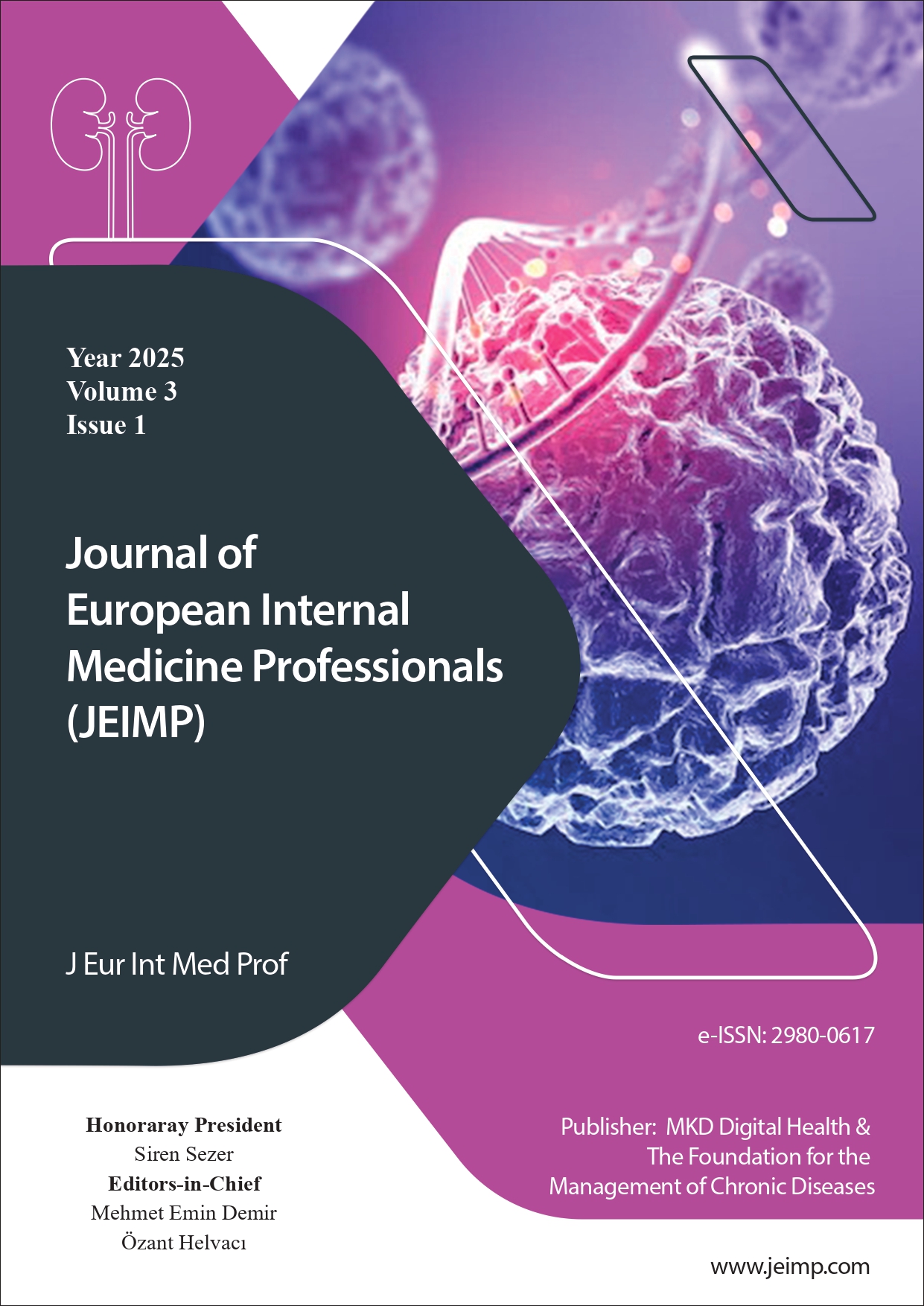Determination of Antifungal Susceptibilities of Candida Species Isolated from Various Clinical Samples: An 8-Year Retrospective Study
Antifungal Susceptibility of Candida Strains
DOI:
https://doi.org/10.5281/zenodo.14775596Keywords:
Candida, Drug Resistance, Fungal, Antifungal Agents / pharmacologyAbstract
Background: The rate of fungal infection has increased due to advances in medical and surgical treatment. Recently, Candidiasis has become one of the major fungal infections among hospitalized patients. While various Candida species may cause the same clinical manifestations, they may also have different antifungal susceptibility patterns. The aim of this study was to determine the distribution and antifungal susceptibilities of Candida species isolated from various clinical specimens.
Methods: Various Candida species were isolated from different clinical samples sent to Acıbadem Labmed Medical Laboratory between 2015 and 2023. Antibiotic susceptibility studies of isolated Candida species were performed with Yeast one kit (Thermo Scientific™, USA) and the results were evaluated according to CLSI data.
Results: From 922 samples, most common species isolated was C. albicans (30.9%), followed by C. parapsilosis, C. glabrata, C. tropicalis and C. krusei. Candida species were sensitive to Fluconazole 76.2%, Itraconazole 64.1%, Voriconazole 93.1%, Anidulafungin 99.1%, Micafungin 99.1%, Caspofungin 98.9% and Flucytosine 92.6%. The antibiotic resistance rates of Candida species were Fluconazole 15.5%, Itraconazole 8.1%, Voriconazole 4.5%, Anidulafungin 0.7%, Micafungin 0.2%, Caspofungin 0.8% and Flucytosine 1.9%.
Conclusion: Speciation of Candida and antifungal susceptibility testing should be done routinely to prevent therapeutic failures.
References
Pappas PG, Lionakis MS, Arendrup MC, Ostrosky-Zeichner L, Kullberg BJ. Invasive candidiasis. Nat Rev Dis Primers. 2018;4:18026. Published 2018 May 11. doi:10.1038/nrdp.2018.26
Yang B, Wei Z, Wu M, Lai Y, Zhao W. A clinical analysis of Candida tropicalis bloodstream infections associated with hematological diseases, and antifungal susceptibility: a retrospective survey. Front Microbiol. 2023;14:1092175. Published 2023 Jul 14. doi:10.3389/fmicb.2023.1092175
Temiz H, Temiz S, Kaya S. Distribution and antifungal susceptibilities of Candida species isolated from various clinical samples. Okmeydanı Med J. 2015;31(1):13-17.
Reda NM, Hassan RM, Salem ST, Yousef RHA. Prevalence and species distribution of Candida bloodstream infection in children and adults in two teaching university hospitals in Egypt: first report of Candida kefyr. Infection. 2023;51(2):389-395. doi:10.1007/s15010-022-01888-7
Quindós G, Marcos-Arias C, San-Millán R, Mateo E, Eraso E. The continuous changes in the aetiology and epidemiology of invasive candidiasis: from familiar Candida albicans to multiresistant Candida auris. Int Microbiol. 2018;21(3):107-119. doi:10.1007/s10123-018-0014-1
Barantsevich N, Barantsevich E. Diagnosis and Treatment of Invasive Candidiasis. Antibiotics (Basel). 2022;11(6):718. Published 2022 May 26. doi:10.3390/antibiotics11060718
Kadosh D, Mundodi V. A Re-Evaluation of the Relationship between Morphology and Pathogenicity in Candida Species. J Fungi (Basel). 2020;6(1):13. Published 2020 Jan 13. doi:10.3390/jof6010013
Babb J, Clark A, Gaffney D, Abdelfattah K, Prokesch BC. Little Utility of Fungal Blood Cultures in Surgical and Burn Intensive Care Units. Microbiol Spectr. 2022;10(4):e0022822. doi:10.1128/spectrum.00228-22
Musinguzi B, Sande OJ, Mboowa G, Baguma A, Itabangi H, Achan B. Laboratory diagnosis of candidiasis. In: Candida and Candidiasis. IntechOpen; 2023.
Fang W, Wu J, Cheng M, et al. Diagnosis of invasive fungal infections: challenges and recent developments. J Biomed Sci. 2023;30(1):42. Published 2023 Jun 19. doi:10.1186/s12929-023-00926-2
Aslani N, Kokabi R, Moradi F, Abbasi K, Vaseghi N, Afsarian MH. Characterization of Candida species isolated from vulvovaginal candidiasis by MALDI-TOF with in vitro antifungal susceptibility profiles. Curr Med Mycol. 2021;7(4):6-11. doi:10.18502/cmm.7.4.8405
Fioriti S, Brescini L, Pallotta F, Canovari B, Morroni G, Barchiesi F. Antifungal Combinations against Candida Species: From Bench to Bedside. J Fungi (Basel). 2022;8(10):1077. Published 2022 Oct 13. doi:10.3390/jof8101077
Cowen LE, Sanglard D, Howard SJ, Rogers PD, Perlin DS. Mechanisms of Antifungal Drug Resistance. Cold Spring Harb Perspect Med. 2014;5(7):a019752. Published 2014 Nov 10. doi:10.1101/cshperspect.a019752
Whaley SG, Berkow EL, Rybak JM, Nishimoto AT, Barker KS, Rogers PD. Azole Antifungal Resistance in Candida albicans and Emerging Non-albicans Candida Species. Front Microbiol. 2017;7:2173. Published 2017 Jan 12. doi:10.3389/fmicb.2016.02173
Gonzalez-Lara MF, Ostrosky-Zeichner L. Invasive Candidiasis. Semin Respir Crit Care Med. 2020;41(1):3-12. doi:10.1055/s-0040-1701215
Kumar S, Kumar A, Roudbary M, Mohammadi R, Černáková L, Rodrigues CF. Overview on the Infections Related to Rare Candida Species. Pathogens. 2022;11(9):963. Published 2022 Aug 24. doi:10.3390/pathogens11090963
Krishnasamy L, Krishnakumar S, Kumaramanickavel G, Saikumar C. Molecular mechanisms of antifungal drug resistance in Candida species. J Clin Diagn Res. 2018;12(9):DE01-DE06.
Lee Y, Puumala E, Robbins N, Cowen LE. Antifungal Drug Resistance: Molecular Mechanisms in Candida albicans and Beyond. Chem Rev. 2021;121(6):3390-3411. doi:10.1021/acs.chemrev.0c00199
Silva S, Rodrigues CF, Araújo D, Rodrigues ME, Henriques M. Candida Species Biofilms' Antifungal Resistance. J Fungi (Basel). 2017;3(1):8. Published 2017 Feb 21. doi:10.3390/jof3010008
Mohammadi F, Hemmat N, Bajalan Z, Javadi A. Analysis of Biofilm-Related Genes and Antifungal Susceptibility Pattern of Vaginal Candida albicans and Non-Candida albicans Species. Biomed Res Int. 2021;2021:5598907. Published 2021 May 28. doi:10.1155/2021/5598907
Kaur J, Nobile CJ. Antifungal drug-resistance mechanisms in Candida biofilms. Curr Opin Microbiol. 2023;71:102237. doi:10.1016/j.mib.2022.102237
Sobel JD. Role of antifungal susceptibility tests in the treatment of vulvovaginal candidiasis. Curr Infect Dis Rep. 2023;25(3):29-32.
Pristov KE, Ghannoum MA. Resistance of Candida to azoles and echinocandins worldwide. Clin Microbiol Infect. 2019;25(7):792-798. doi:10.1016/j.cmi.2019.03.028
Arendrup MC, Friberg N, Mares M, et al. How to interpret MICs of antifungal compounds according to the revised clinical breakpoints v. 10.0 European committee on antimicrobial susceptibility testing (EUCAST). Clin Microbiol Infect. 2020;26(11):1464-1472. doi:10.1016/j.cmi.2020.06.007
Trek Diagnostic Systems. Sensititre search tool. http://www.trekds.com/techinfo/. Accessed March 24, 2018.
Pfaller MA, Jones RN, Doern GV, Sader HS, Hollis RJ, Messer SA. International surveillance of bloodstream infections due to Candida species: frequency of occurrence and antifungal susceptibilities of isolates collected in 1997 in the United States, Canada, and South America for the SENTRY Program. The SENTRY Participant Group. J Clin Microbiol. 1998;36(7):1886-1889. doi:10.1128/JCM.36.7.1886-1889.1998
Comert F, Kulah C, Aktas E, Eroglu O, Ozlu N. Identification of Candida species isolated from patients in intensive care unit and in vitro susceptibility to fluconazole for a 3-year period. Mycoses. 2007;50(1):52-57. doi:10.1111/j.1439-0507.2006.01309.x
St-Germain G, Laverdière M, Pelletier R, et al. Prevalence and antifungal susceptibility of 442 Candida isolates from blood and other normally sterile sites: results of a 2-year (1996 to 1998) multicenter surveillance study in Quebec, Canada. J Clin Microbiol. 2001;39(3):949-953. doi:10.1128/JCM.39.3.949-953.2001
Erdem F, Tuncer Ertem G, Oral B, Karakoç E, Demiröz AP, Tülek N. Candida Türlerine Bağlı Nozokomiyal Enfeksiyonların Epidemiyolojik ve Mikrobiyolojik Açıdan Değerlendirilmesi [Epidemiological and microbiological evaluation of nosocomial infections caused by Candida species]. Mikrobiyol Bul. 2012;46(4):637-648.
Gnat S, Łagowski D, Nowakiewicz A, Dyląg M. A global view on fungal infections in humans and animals: opportunistic infections and microsporidioses. J Appl Microbiol. 2021;131(5):2095-2113. doi:10.1111/jam.15032
al M, Gebrezgabher W, Samajpati N, Manna AK. Growing role of non-Candida albicans species in clinical disorders of humans and animals. J Mycopathol Res. 2015;53(1):41-48.
Pfaller MA, Diekema DJ. Epidemiology of invasive candidiasis: a persistent public health problem. Clin Microbiol Rev. 2007;20(1):133-163. doi:10.1128/CMR.00029-06
Cuenca-Estrella M, Gomez-Lopez A, Alastruey-Izquierdo A, et al. Comparison of the Vitek 2 antifungal susceptibility system with the clinical and laboratory standards institute (CLSI) and European Committee on Antimicrobial Susceptibility Testing (EUCAST) Broth Microdilution Reference Methods and with the Sensititre YeastOne and Etest techniques for in vitro detection of antifungal resistance in yeast isolates. J Clin Microbiol. 2010;48(5):1782-1786. doi:10.1128/JCM.02316-09
Siqueira RA, Doi AM, de Petrus Crossara PP, et al. Evaluation of two commercial methods for the susceptibility testing of Candida species: Vitek 2® and Sensititre YeastOne®. Rev Iberoam Micol. 2018;35(2):83-87. doi:10.1016/j.riam.2017.11.001
Karaaslan R, Aktaş E, Orhan F. An investigation of antifungal susceptibilities of the Candida species isolates from blood cultures using the Sensititre YeastOne microdilution method. Turk Hij Den Biyol Derg. 2020;77(3):281-288.
Avolio M, Grosso S, Bruschetta G, De Rosa R, Camporese A. Direct antifungal susceptibility testing of positive Candida blood cultures by sensititre YeastOne. New Microbiol. 2009;32(2):179-184.
Pappas PG, Rex JH, Lee J, et al. A prospective observational study of candidemia: epidemiology, therapy, and influences on mortality in hospitalized adult and pediatric patients. Clin Infect Dis. 2003;37(5):634-643. doi:10.1086/376906
İris-Efe N, Ersöz-Arat M, Şimşek F. Yoğun bakım ünitelerinde yatan hastalardan izole edilen Candida türlerinin identifikasyonu ve antifungal duyarlılıklarının araştırılması. Klimik Derg. 2008;21(2):61-64.
Bayram Y, Gültepe B, Güdücüoğlu H. Çeşitli klinik örneklerden izole edilen Candida kökenlerinin identifikasyonu ve antifungal duyarlılıklarının araştırılması. Van Tıp Derg. 2012;19(4):177-181.
Özbek E, Tekay F, Pirinççioğlu HÇ. Yoğun bakım hastalarına ait çeşitli örneklerden izole edilen Candida izolatlarında antifungal direnç. Dicle Tıp Derg. 2012;39(2):207-212.
Atalay MA, Sav H, Demir G, Koç AN. Kan kültürlerinden izole edilen Candida türlerinin dağılımı ve amfoterisin B ve flukonazole in vitro duyarlılıkları. Selçuk Tıp Derg. 2012;28(3):149-151.
Çalışkan E, Dede A, Güven GB. Kan kültürlerinde saptanan Candida türlerinin dağılımı ve antifungal duyarlılıkları. ANKEM Derg. 2013;27(1):25-30.
Johnson LB, Kauffman CA. Voriconazole: a new triazole antifungal agent. Clin Infect Dis. 2003;36(5):630-637. doi:10.1086/367933
World Health Organization. WHO fungal priority pathogens list to guide research, development and public health action. Published October 25, 2022. Accessed May 26, 2022. https://www.who.int/publications/i/item/9789240060241
Kathuria S, Singh PK, Sharma C, et al. Multidrug-Resistant Candida auris Misidentified as Candida haemulonii: Characterization by Matrix-Assisted Laser Desorption Ionization-Time of Flight Mass Spectrometry and DNA Sequencing and Its Antifungal Susceptibility Profile Variability by Vitek 2, CLSI Broth Microdilution, and Etest Method. J Clin Microbiol. 2015;53(6):1823-1830. doi:10.1128/JCM.00367-15
Chowdhary A, Prakash A, Sharma C, et al. A multicentre study of antifungal susceptibility patterns among 350 Candida auris isolates (2009-17) in India: role of the ERG11 and FKS1 genes in azole and echinocandin resistance. J Antimicrob Chemother. 2018;73(4):891-899. doi:10.1093/jac/dkx480
Patwardhan SA, Prayag PS, Soman RN, et al. Candida auris - Comparison of sensititre YeastOne and Vitek 2 AST systems for antifungal susceptibility testing - A single centre experience. Indian J Med Microbiol. 2024;50:100618. doi:10.1016/j.ijmmb.2024.100618
Downloads
Published
How to Cite
Issue
Section
License
Copyright (c) 2025 Nihan Ünübol, Neval Yurttutan Uyar, Meltem Ayas

This work is licensed under a Creative Commons Attribution 4.0 International License.










